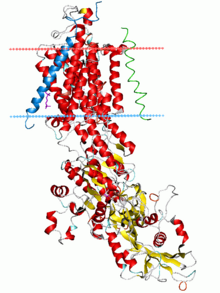Sodium-potassium pump
| Na+/K+ ATPase pump | |||||||||
|---|---|---|---|---|---|---|---|---|---|

Sodium-potassium pump, E2-Pi state. Calculated hydrocarbon boundaries of the lipid bilayer are shown as blue (intracellular) and red (extracellular) planes
|
|||||||||
| Identifiers | |||||||||
| EC number | 3.6.3.9 | ||||||||
| Databases | |||||||||
| IntEnz | IntEnz view | ||||||||
| BRENDA | BRENDA entry | ||||||||
| ExPASy | NiceZyme view | ||||||||
| KEGG | KEGG entry | ||||||||
| MetaCyc | metabolic pathway | ||||||||
| PRIAM | profile | ||||||||
| PDB structures | RCSB PDB PDBe PDBsum | ||||||||
|
|||||||||
| Search | |
|---|---|
| PMC | articles |
| PubMed | articles |
| NCBI | proteins |
Na+
/K+
-ATPase (sodium-potassium adenosine triphosphatase, also known as the Na+
/K+
pump or sodium-potassium pump) is an enzyme (EC 3.6.3.9) (an electrogenic transmembrane ATPase) found in the plasma membrane of all animal cells. The Na+
/K+
-ATPase enzyme is a solute pump that pumps sodium out of cells while pumping potassium into cells, both against their concentration gradients. This pumping is active (i.e. it uses energy from ATP) and is important for cell physiology. An example application is nerve conduction.
It has antiporter-like activity, but since it moves both molecules against their concentration gradients it is not a true antiporter, which would require one solute to move with its gradient, not against it.
Active transport is responsible for the fact that cells contain a relatively high concentration of potassium ions but low concentrations of sodium ions. The mechanism responsible for this is the sodium-potassium pump, which moves these two ions in opposite directions across the plasma membrane. This was investigated by following the passage of radioactively labeled ions across the plasma membrane of certain cells. It was found that the concentrations of sodium and potassium ions on the two sides of the membrane are interdependent, suggesting that the same carrier transports both ions. It is now known that the carrier is an ATP-ase and that it pumps three sodium ions out of the cell for every two potassium ions pumped in.
...
Wikipedia
